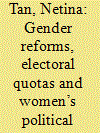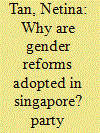|
|
|
Sort Order |
|
|
|
Items / Page
|
|
|
|
|
|
|
| Srl | Item |
| 1 |
ID:
145753


|
|
|
|
|
| Summary/Abstract |
In the last two decades, more than 118 countries and political parties around the world have introduced gender quotas to guarantee women’s political representation. While the study of gender quotas and electoral systems is an exciting field, few studies have focused on East Asia. Why do traditionally male-dominated parties engage in gender reforms? Have gender reforms improved women’s political representation and participation? To address these questions, this introductory article offers an overview of the electoral rules, gender quotas, and candidate selection methods adopted in three broadly similar cases with different outcomes in Taiwan, South Korea, and Singapore. Taiwan and South Korea introduced mixed electoral systems and legislated candidate quotas to improve women’s legislative representation at the local and national levels. Singapore resisted legislating gender quotas while the ruling party voluntarily introduced a party quota in 2009. These gender equality strategies have brought slow and uneven results. Based on qualitative and quantitative methods as well as survey and electoral data, this paper offers new evidence showing why the effects of electoral systems and quota strategies are not automatic or mechanical, but dependent on the degree of party system institutionalization, electoral competitiveness, legal enforcement, and social-cultural attitudes toward women.
|
|
|
|
|
|
|
|
|
|
|
|
|
|
|
|
| 2 |
ID:
145756


|
|
|
|
|
| Summary/Abstract |
In Singapore, the percentage of elected female politicians rose from 3.8 percent in 1984 to 22.5 percent after the 2015 general election. After years of exclusion, why were gender reforms adopted and how did they lead to more women in political office? Unlike South Korea and Taiwan, this paper shows that in Singapore party pragmatism rather than international diffusion of gender equality norms, feminist lobbying, or rival party pressures drove gender reforms. It is argued that the ruling People’s Action Party’s (PAP) strategic and electoral calculations to maintain hegemonic rule drove its policy u-turn to nominate an average of about 17.6 percent female candidates in the last three elections. Similar to the PAP’s bid to capture women voters in the 1959 elections, it had to alter its patriarchal, conservative image to appeal to the younger, progressive electorate in the 2000s. Additionally, Singapore’s electoral system that includes multi-member constituencies based on plurality party bloc vote rule also makes it easier to include women and diversify the party slate. But despite the strategic and electoral incentives, a gender gap remains. Drawing from a range of public opinion data, this paper explains why traditional gender stereotypes, biased social norms, and unequal family responsibilities may hold women back from full political participation.
|
|
|
|
|
|
|
|
|
|
|
|
|
|
|
|
|
|
|
|
|